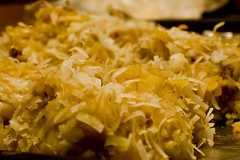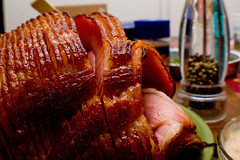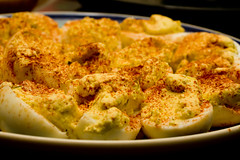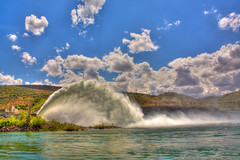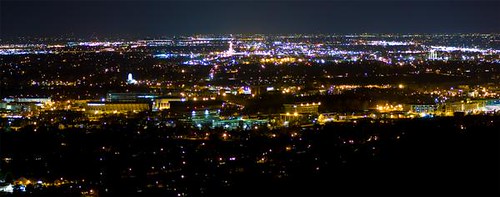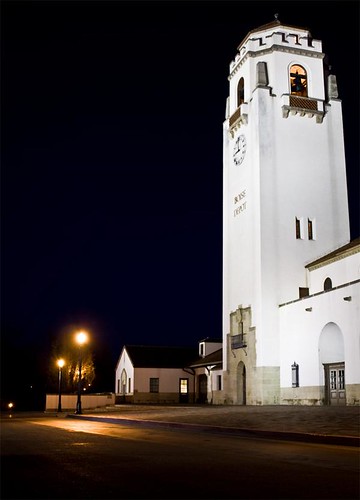Sunday, December 14, 2008
Photographing a miniature
So, I figured the light clouds, and all the white snow would make for VERY even lightning. It turned out right. My first pictures, put the miniature on the right side of the frame, and it really looked weird. I moved it to the left of the frame, and I really liked it. After a touch of cropping I came up with these two pictures.
My girlfriend suggested bumping the exposure a bit, and blowing out the background. That probably would have been a bit better, though, I am still very happy with these pictures.
Wednesday, December 10, 2008
Books, Books, and MORE BOOKS! (Very Long)
So, for the first book... this is a very important position. Three books jump out at me, at once. I guess I will start from the more basic, to more advanced.
For the absolute beginner, I would have to go with BetterPhoto Guide to Digital Photography. This is a good book for people with digital cameras. Be it point and shoot, or SLR. There is a lot in here that will be covered later, but it is a great primer. Very easy to read.
For the next one, it is actually a 2 book set. I would recommend Scott Kelby's Digital Photography Boxed Set. When I bought it, it was 2 separate books. Now, you can get a single gift set. The books complement each other very well. This is a more basic book, with advanced sections. That is not quite right. He tends to tell you what to do, and less HOW to do it. The end sections I would love to see him come out with, as flash cards, that are weather resistant. Once again, it is more of, do this... and this is how you do it. Very cool concept. Scott Kelby is pretty much a god, when it comes to digital imaging. He also has a GREAT sense of humor, which makes reading his books excessively easy.
For the next book, I would recommend, I would have to go to Understanding Exposure. This is one of the more popular books that I have seen. Amazon is showing 484 customer reviews at 4.5 stars. I think that alone, is a testament to this book. I find Bryan Peterson books, easy to read. This book goes in depth about creating "artistically correct" exposures. You can create several pictures of the same object, using different exposures. They are all technically correct, but there is only one artistically correct exposure, for you. It is a very interesting concept, and something that he follows through several books. He also goes in depth about the interaction of Aperture, ISO, and Shutter Speed. This a very KEY aspect to photography.
Those are three GREAT books, to get started with, learning photography. I recommend them all.
One other book, that is good in its own right, but I don't think it is quite up there with the other three, is another book by Bryan Peterson. This one is called Understanding Digital Photography. The reason I show some hesitation on this book, is that while I really like it... some of the advice seems to be a little off. For one, I would not recommend blowing out your sensor with compressed air. Just a few minor issues, in a technically good book. Once again, Bryan Peterson is a creative photographer, and you can see his love for the medium shine through. His pictures that go along with the concepts are spot on. This one is pretty much interchangeable with the first book on my list. I think the Betterphoto book, is just a touch better on the beginner book, though.
The next book is my final Bryan Peterson book. This one is Learning to See Creatively. Learning to See Creatively was the first photography book I purchased. I was able to read it all, cover to cover, in one evening. It is not difficult to digest. Lots of pictures. This one, more than all of my other books, really OPENED my eyes to the creative side of photography. (I am kind of a tech-head, so come to photography with a VERY tech, look. Not as creative). This book will always hold a special place in my heart. It is also the book that pushed me into getting my first dSLR camera, since all of the sudden my Point and Shoot was holding me back.
Now, from here on out, I am going to be talking about books that speak to my favorite aspects of photography.
My first "love" in photography, would have to be macro photography. I love doing it. I question if I have the patience at times to do it WELL, but I truly do love it. So, I have picked up two books on the subject. The first one, is Digital Macro Photography. This is done by a younger gentleman. I think he needs to refine his writing style a bit, but he does a good job of explaining concepts. He has some truly outstanding pictures to illustrate his points, as well.
The next book that I have, is John Shaw's Closeups in Nature. I know that John Shaw is one of the top writers in photography, but I just have some troubles recommending his books. The pictures themselves are QUITE stunning, but I am not a big fan of his writing style, and these books are a DEFINITE throw-back to the film era where he talks about film selection for different pictures. Just not my bag of tea. And quite honestly, god I am glad I don't have to shoot film!
From there, I will take you into another aspect of photography I love, HDR, or High Dynamic Range photography.
The first book I want to talk about is Complete Guide to High Dynamic Range Digital Photography. I think the title is misleading. I have another HDR book, that is much more complete. I would say this would be better called HDR for everyone that wants to learn how to shoot HDR. :-) This is really a great book. Awesome examples, and several different ways of looking at things. HDR made easy. I REALLY like this book.
The second HDR book in my collection is The HDRI Handbook. This one really does fall under the "complete" category, more so than the title above. This one is VERY complete. It is more complete than what I have been really interested in, though. There is some VERY good information on where HDR came from, and a LOT more technical background. I found it a bit dry to read though. I know this is a bit rough of a review, but I want to temper it by saying that this book is VERY good. VERY technical, and definitely a great addition to my library.
This last book is one that I am still not 100% sure about. It is called The Photo Idea Index. This book gives you ideas on how to shoot pictures. TONS of different ideas, and pictures to back them up. It doesn't seem to be technically, that great. But, it is GOOD when your brain is in a slump. I REALLY like the "flash cards" in the back of Scott Kelby's two books, and I almost feel that this BOOK is a lot like those. I have a hard time recommending this book, because it is odd. It fits in a weird spot, though, I wouldn't give it up, and am happy I own it.
So, those are books on Photography. I have a few additional books that go along with photography. These are books on post processing. The first one I got, was Photoshop Elements 6 Missing Manual. A bit dry, but a GREAT manual. I had it get wet, and ruined, so I have not read as much of it, as I would have liked. The other Adobe Elements 6 book I have is Photoshop Elements 6 for Digital Photographers. This is another Scott Kelby book. This one TOO was ruined in the great flood... but I have re-purchased it. It is not as technically complete as the missing manual, but it more than makes up for it by being REALLY easy to read, and has great illustrations.
My latest book on post processing, is another Scott Kelby Book. It is Lightroom 2.0 for Digital Photographers. This book is VERY much like the Photoshop Elements book in look and feel. It is a must-have book for any LR2.0 user.
Once I am able to get some more books, I have several on my list. They range from another Bryan Peterson book, kind of Understanding Exposure 2, to more specialized books on low-light, portraits, landscapes. What I am planning on getting, coming up are:
Understanding shutter speed
Beyond Portraiture
Night and Low Light Photography
Understanding Close-Up Photography
Digital SLR Expert Landscapes
Low Budget Shooting
Working with Light
The moment it clicks
I think it would be difficult to really read a book, and look at someone else's photographs, and not come out with further insights in how to take pictures, or how to see the world, in that slightly different way. How to see light, even more so than the scene. I think that is what these books help you to do. Garner further understanding of light, and photography.
Finally, books are fine and all, but if you want a great photographic experience, check out Art Wolfe's Travels to the Edge on your local PBS station. Getting someone like him to talk about photography, and those items that surround it, and then seeing what they produce is quite an experience. It is available to snag on your DVR, or pick up on DVD.
If you have any other suggestions, please feel free to add some comments.
Sunday, November 30, 2008
KT Life Studios is now Live! Portraits, Fine Art, Stock and more.
It's Thanksgiving!
Friday, November 21, 2008
i Make Decisions (iPhone and iTouch) is up on Idahostatesman.com
Wednesday, November 12, 2008
Night time HDR.
Tuesday, November 11, 2008
Pick a winner, make a decision: i Make Decisions for the iphone and ipod touch from Apple.
i Make Decisions is a GREAT program to help you through those rough patches in life. When you reach a fork in the road, it is always better to let the winds of chance decide, since they will not let you down, unlike your cluttered thinking. That is where iMakeDecisions comes in. i Make Decisions has a bunch of decision making applications, in one. The program includes Magic Eight Ball, Coin flip, random number generators (for you web designers out there, get the creative muse jump started with a random color generator), wishbone, rock paper scissors, will it stick, darts, random card, which way, spinner, and stats for some of the pieces. This thing has it all. And, making effective decisions is ALWAYS a good place to start!
So, if you STILL want more information, you can check out the press release at http://pitch.pe/1253.
You can download i Make Decisions through the website, or click on this link which takes you right to the apple store.
I am good friends with the people that made this app. They are some terrific guys, that definitely deserve the measly $1.99 for this app. You will easily get more use out of it, than that little bit of money.
Saturday, November 8, 2008
Finding the moment...
Photography does an amazing thing to one's way of thinking. You quit looking at things, and start SEEING things. How the light plays across the sky, or a dropping sun bottom lights clouds high up above your head, even though it has dipped over the horizon. How the "feel" of a room is completely changed, by a coat of light green paint. It has been a truely eye-opening experience. So, I have driven out in this area all my life, yet never SAW the area. I am now looking all over to find fun and interesting things to shoot. Unforutnately, I found out where I went, at least initially was pretty dang boring.
After that false start, I found this little area. First, there was an old, small cemetary. Maybe two dozen grave markers were there. It was just a small plot, in the edge of a field.
After I found this, just down the road, was an old church. The cross laying against the side, with the shadow of an old basketball hooop I found to be a great contrast. Also the front of the church, showing its age. The weathered, serene church comes from a different time. A church that has seen generations.
As the sun went down, I couldnt find a great sunset shot. I was disappointed in that. I continued to drive around, looking for some fall color, to come back to. I had not been out to lake lowell, since I was a child. So, I decided to follow the signs to go out that direction. I ended up coming over a hill, and was presented with a great shot of colors along the side of the lake. Unfortuantely, the light was too low for a decent shot. It was VERY bland. I continued driving around, scouting for some more spots to come back to. The darkness was closing in, and my photography was over the night... at least, until I came around a corner, and saw this amazing color.
I was amazed by the color. I used my XSi's live view. By moving the reticle, I changed the look and feel of the color, by changing where I was looking at, for exposure. I took a bunch of pictures here, and they pretty much all turned out perfect. The ones I posted, were just a little MORE perfect.
On the way home, I came across an interesting intersection, and had to get a picture of it.
Finally, on the way home, I had been wanting to get a panorama shot of Boise, at night, which I did.
Tuesday, September 2, 2008
It's been a while, more High Dynamic Range (HDR)
I love the depth of color. When looking at the properly exposed photo, the bottle is VERY flat and lifeless. The addition of HDR, in this photo, adds a depth that is just missing from conventional photography.
Next up, is one of my new favorites. We were taking a trip to my cousin’s wedding in California, when my 3 year old daughter pipes up and tells us that she has to go potty. There was NOTHING around. This was a VERY desolate piece of road in Oregon, so we pull over on the side of the road in a turnout. She tries to pull her pants down, and go, but has trouble going without a toilet. But, we took advantage of the stop to walk around a bit. I took advantage of it, to take some great shots. The sky was very pretty, with those feathery clouds. I put my circular polarizer on, to get some nice pop to the sky. I then set my camera to Auto Exposure Bracketing. I set the camera on my car, and fired off 3 pictures quickly, trying to keep shaking to a minimum. This was a VERY simple shot to do. Just loaded it in photomatix, adjusted a few sliders, until I was happy, and rendered it. I then cut off a bit of the bottom of the picture, since you could see a piece of my hood in there. That was all the processing this required. I love how it looks:
I just love how HDR can take a mundane photo and it then just pops out at you, when processed correctly.
Wednesday, June 4, 2008
First official "photo shoot".
The problem, is that the light was BAD. I do not have a lot of experience running my camera at high ISOs, so I kept it at 400, and hoped for the best. I learned a few things. Taking pictures of people talking, I SHOULD have run it up to 1600. They just did NOT turn out well. Even with the flash (which I used EXTREMELY sparingly, to prevent distraction). When you have a presentation going on, especially something SERIOUS, people sit VERY still. THAT is the time to crank the ISO down, and take shots of the audience. I also came to LOVE live view on my camera. When shooting macro, and landscapes, I use live view a lot, but in this setting is really rocked. I was told today, that the pictures were very well done, and they were impressed with the level of focus on some subjects. So, here is my secret. I used live view, with a remote shutter release, to prevent camera shake. After live view was up, I would compose my shot. Then, I would move the focus square over the person, or area I wanted in focus, and hit the magnify button. That would REALLY magnify the subject, and I would manually focus on that person. From there, it was as simple as putting my remote shutter release in front of the camera, hitting the shutter button, and the picture was taken.
Most of my shots were with a full tripod, with the head part extended to my eye level (6'). It was pretty wobbly, so I tried to avoid touching it, as much as possible. After taking pictures for about 2/3 of the event with that, I went up stairs, and lowered the head all the way back down, to try and get some more stability. I then shot down on the audience from above. I got some good pictures there, with my wide-angle lens. Once I came back down, I started shooting with the collapsed head, so I was taking pictures from just above the audiences point of view, giving me a different, and unique perspective of the event.
So, a few things learned from this. Carry your equipment with you, ALL THE TIME. I got this opportunity, because my camera bag was in my car. (as was my tripod and monopod). When shooting in low light, crank the ISO up. Good, sharp, somewhat graining pictures trump good, blurry, pictures, that have low noise. Move your perspective around. I shot over the audience(from a balcony area), at audience level, as well as some good general shots about a head’s height higher than the seated audience. Move around. I literally shot, throughout the night, in about a 180 degrees from one side to the next, carrying my tripod with me. I wish I had shot the dinner trays, and other items, to give a better, full feeling to the event. I also wish I had asked the presenters to each walk back with me, so I could get a GOOD picture of them. Finally, I wish this had been "planned" and I could have gotten there earlier. I was one of the last ones to eat, and finished JUST before the presentation. I volunteered to shoot, while in line, waiting to get my food. It did NOT give me much time to get stuff together, and ready to shoot. Finally, I needed a better tripod. I have that now (yea me). That should help greatly, in the future.
It sounds like I did a good enough job, that the art department is looking at using me in future photo shoots, like this. That is kind of exciting.
Tuesday, June 3, 2008
A lucky shot : snake on a rock

My flickr site also features another picture, with the snake's eye looking forward.
Monday, June 2, 2008
Filters
But, that is not where it ends, at least for me. I also have a Cokin P filter holder. The nice thing about this, is that it holds up to 3 filters at once, and allows you to use them on different sized lenses. Since my Macro is 52mm, and my other lenses are all 58mm, this is kind of important.
So, for the Cokin, I have 5 filters. The first three, graduated neutral density filters, came as a set, with the filter holder. This allows me to darken the sky, while leaving the ground bright, so I can balance light. Yea, it can be done in post, but it is usually quicker, and (at least for me) easier to get it done on camera. I also have a mid-range neutral density filter. This one, darkens the scene, so I can use a slower shutter speed. So far, I have used it on water, to give water that silky, moving quality. Finally, my last filter is another graduated filter, but instead of grey, to darken things, this one is blue, to give the sky a bit of a pop. Personally, I like a nice, dark blue sky, and in summers around here, the sky turns kind of pale. I am planning on using this filter to make it look a bit better.
My next filter that is kind of fun to play with, is an infrared filter. This allows you to shoot in the infrared spectrum, outside what our eyes can see. It creates a more surreal look to photographs. It is also a “black and white” medium. You convert the pictures from their red-tinged look, to black and white, for the best effect. This filter works REALLY well, in bright sunlight, so while most photographers are running off in the middle of the day, you can continue to fire off pictures, taking advantage of all the additional light.
My last filter, is the filter of controversy. It is the UV filter. Ultimately, for me, it doesn’t do anything. (From what I understand, if you see a “UV haze” in the air, this will help cut it down… but that is not why probably 98% of the people pick it up). Most people use it to protect their lens. A $20-40 filter, getting scratched is a LOT less painful, than a $300+ lens getting scratched. Honestly, I don’t use them much, but one time, I was looking for birds (birds in flight) and wanted to leave the lens-cap off, and have the camera ready to fire. Well, I put the UV filter on, JUST in case. Now, the negatives. These filters are going to degrade your picture. Light is going through more, coated glass. It happens. You also loose light. Depending on the person, these negatives are far worse than the positives. I tend to fit in the middle. If I am in an area, like walking in the park, I leave the filters off. The “danger” level, goes down. It is flat ground, nice paths, and the like. If I am going off the trail, or something, then I put the UV filter on.
There is my little run-down, and primer on filters. There are a lot out there. I hope to eventually pick up an enhancement filter (jeeze, THOSE are expensive) a circular polarizer for my cokin, as well as the other 2 neutral density cokin filters.

With this shot, my IR filter JUST came in, and I wanted to test it out. You can see that green comes through PRETTY well. It should be converted to Black and White to really make it look better, but this is basically just as shot, with an Infrared filter

Here is a fountain in the park. I used a neutral density filter to slow the shutter speed down, so I could take a picture of the water flowing.
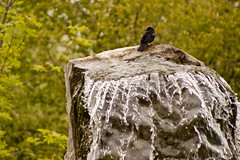
Here is that same fountain. I was taking a picture of the bird, which moves too much to work will slowed down. So, this is what the fountain looked like, without the filter to slow the shot down
Sunday, June 1, 2008
High Dynamic Range photography
If you have spent much time at all, with photography, you will know we have something called the Rule of Thirds. With the cameras themselves, we have THREE distinct settings, used to get the proper lighting: ISO, Shutter Speed, and apature. We take into account the fstop for depth of field. We use technology, to capture art. There are artists out there, that create art, then use a camera to capture it. I will freely admit, I am no where CLOSE to that... but I do like the techy aspect of photography. I have learned how to use ISO to squeeze out a bit better shot, but I realize I am giving up a "clean" image. (due to more "grain" or noise). I have figured out how to use neutral density filters to reduce the light going into my camera, so I can take a longer exposure of a water, to make it look silky. I think I have come a long ways. While I used to actively think about these things, now, it is becoming second nature to a degree. (let’s face it, I have only had my dSLR for just under 2 months, and you can only learn SO much in that time...)
So, for my NEXT geeky move, into photography. It is HDR, or High Dynamic Range imaging. This stuff is pretty cool. There are flickr groups dedicated to it. There is software designed for it (Photomatix and High dynamic Photo) and there seems to be a big buzz about it. It is very cool. While our eyes can see something like 11 "fstops" of range, a picture can pull up between 5 and 7. (I have seen both of those numbers listed). So, our eyes can see a LOT more of a scene than a camera. We can see INTO shadows, and pull out detail, while at the same time, looking over at a bright subject, and seeing detail in there. With a camera, one or both would be blown out, or underexposed, to get a picture. Well, with HDR, we take a series of pictures, and blend them into one. This creates some VERY cool effects, and makes for some very rich pictures. (Peruse the HDR flickr group I linked to above, to see just how cool).
For some reason, my geeky friends love this, as do I. It is, on its surface, very simple. I set my camera to auto-bracket. I fire 1 shot at -1 exposure, 1 at the proper exposure and then one more at +1 exposure. Then, I use one of those two softwares above, to merge it into one picture. I know it is FAR more complicated than that, since Photomatix has 2 settings, one is HDR, and one is blending. To me, they are one in the same (at this point in my journey of knowledge), but, since both are options, I know they are ultimately different.
If you are curious about the quality of the software I list, from what I understand, Photomatix is the most popular piece of software. It is supposed to be able to create the most natural looking pictures. While High Dynamic Photo creates good photos as well… its user-interface is MILES better than Photomatix’s. Ultimately, it depends on what you care more about. Oh, and Photomatix is about double the price of HDP. (as an aside, I bought Photomatix today, to start playing with this stuff, and later in the day, learned about HDP. I doubt I would have gone for Photomatix, because of the price, but if you search well with Google, you CAN find a 15% discount on Photomatix, bringing the price down some)
Now, lets look at some pictures:
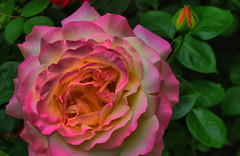
This one was processed with High Dynamic Photo. I had 3 exposures of -1.33/0/+1.33.
 This one was processed with Photomatix. I had 3 exposures of -1.33/0/+1.33.
This one was processed with Photomatix. I had 3 exposures of -1.33/0/+1.33.
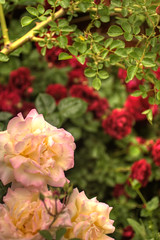
This one was processed with Photomatix. I had 3 exposures of -1.33/0/+1.33.
These are a little different. They were blended, but based on one RAW file. I set one to +1 Exposure and one to -1 exposure saved the 2 files, and then combined them. It was more to test it out. The top one, is "blended" the bottom one was combined using HDR.
Saturday, April 26, 2008
Super Geotagged...
Sunday, April 20, 2008
In the darkness, the fun has just begun.
From a technical standpoint, photography is the art of capturing the light that is reflected off your subject. With the example above, about the night shooting, over Boise, you are capturing the light itself. Figuring out HOW to do that, properly, is a trick. I am ATTEMPTING to capture the vista, in camera, how I want it to turn out, with the least amount of tweaking. This particular shot was shot at 75mm, using f/4, ISO 100 and a 10 second exposure time. A lot of the lights pop MORE than what I want, it was the best of the bunch, the most crisp looking. After I did some processing in raw, and over-saturated some of the colors, I thought that the picture took on a life of its own.
My previous post about low-light, was more concerned with the WHERE to shoot from. This one is more about the why. As I learn more about photography, I get better. In the week between the previous night shot of Boise, and the latest night shot. I have read more, learned more, and upgraded my camera to a Canon XSi. I am pretty sure the biggest change between the previous week and this later week, was a MUCH nicer camera, but that is not all. I noticed with my Canon A650 IS, a LOT of the shots were blurry. This last time I went up, instead of having my tripod behind my car, I put my car between the wind, and the tripod. With the 10, 20, and longer exposures, this made all the difference in the world. It are these little things, that all add up to make a photographer great. I have to look around, and figure out what aspects of a shot I am able to master, and then I try to figure out a method to master them. I am sure that someone with years of experience would have noticed the wind right away, and shielding the camera from the wind, would not have required a conscious thought.
So, I have discovered, I like shooting at night. My other favorites I have discovered are macro, and taking shots of patterns. Finally, I DO love my daughter, as a subject. She is a real ham, and does an amazing job in the front of the camera. Oh, and this weekend, my daughter got her FIRST digital camera. A 5MP, Kodak digital camera I picked up used for her. She had been asking for a camera, to be like daddy for a long time. I look forward to our adventures together.
Saturday, April 19, 2008
How'd I capture that goose?
As for the goose. I uploaded the 4 good ones, to my flickr account. I had a gentleman post this in the comments of one of my pictures: "Very clear and full of expression. Sharp point of focus. I have tried to take photos as clean and clear as this but haven't yet succeeded. I can't get my lighting right even with all the extra knobs. Or maybe it's because of the extra knobs????"
I responded with everything I could remember from taking those pictures: "This shot was taken FAIRLY close, using a 300mm lens. (You can see the information in the exif) I barely can figure out the extra knobs, myself. :-) What I did, is set my camera to aperture priority. I wanted as much light in, as possible, and then hoped it would be a fast shutter. There is a local park, that has a the sun shining down it, as you can see in this picture. It was taken a touch before the magic hour of light, but still pretty close, so that gave me the softer light. To hold the camera as steady as possible, I was sitting down, and pulled my arms tight into my body. Oh, I also set my autofocus to the CENTER point, instead of all of the points. It makes the auto-focus lock on to WHAT you want, and seems to be a lot faster. " I am also including a link to my meta data/exif information.
I hope that helps him. This is all about learning. That is the entire point of this blog. Learn and grow as a photographer. What I find kind of funny, is I was planning on going on this date with this lady last night, and we had planned on walking the park. I knew I could get some shots of waterfowl, and hopefully some other wildlife, there. Yesterday, my copy of Popular Photography came in, and had an article about photographing waterfowl. It seemed like AMAZING timing, to me!
And now, a picture of the goose I have been talking about, and my personal favorite of the night, what I call "The Regal Goose".
 The Regal Goose |
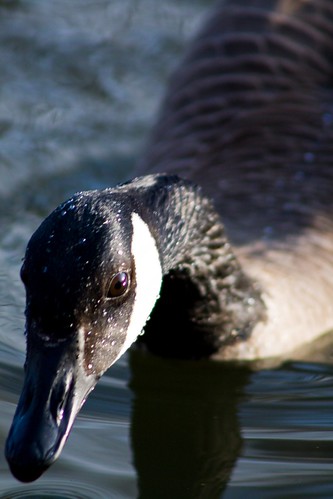 The Curious Goose |
Sunday, April 6, 2008
Shooting in low-light and night.
As I was returning to my car, I heard a scrabbling sound above me, and looked up. There was a herd of deer up there! I started taking pictures. I fired off a bunch of pictures. I was there long enough, that the herd came down the hill, and went over to the lot I had been shooting pictures of Boise from! It was pretty cool. I fired off 34 pictures, and got 1 that is ok. Most are about snapshot quality. The biggest problem, was shooting in low-light again. I was kind of fighting my camera tonight, on the low-lighting issue. It kept jumping up to ISO800, which is TERRIBLY noisy. Though, the deer were not keeping still much, so running at a lower ISO with a longer shutter, may not have worked well, either.
I started my trip off, looking for the road up to Table Rock. It has been a LOT of years since I last went up there. Even though, I did not find it intially, I did find a cool spot, to shoot from.
After I packed up, I decided to look around to see if I could find where the road to Table Rock was. I DID find it, though, there is now a gate they lock after sundown. On the way back down the hill, I found a great shot of Boise. By this time, it was pretty dark, so Boise was alight, with, uh, light. I took some pictures, and a few turned out pretty cool, though, it could have been better. I tried running at ISO 100, with a long shutter, and that did not work. There was a bit of wind, and I NEVER thought some wind would cause my camera to shake as much as it did.

Saturday, April 5, 2008
Pictures... of paintballs.

 Then, we have a kind of interesting picture. Not GREAT, but an interesting picture none the less. This bridge support is covered in paintball splatters, unfortunately. But, the thing I wanted, was the shadow, cast by the tree on it. After playing with it a touch in Photoshop Elements, I have brought out the shadow a bit more, and really, just ramped up the colors and sharpness. I think it is interesting, but would have been better, if it had been a clean support.
Then, we have a kind of interesting picture. Not GREAT, but an interesting picture none the less. This bridge support is covered in paintball splatters, unfortunately. But, the thing I wanted, was the shadow, cast by the tree on it. After playing with it a touch in Photoshop Elements, I have brought out the shadow a bit more, and really, just ramped up the colors and sharpness. I think it is interesting, but would have been better, if it had been a clean support.
Another Day, another picture.
I finally received my new book, The Photoshop Elements 6 Book for Digital Photographers
I did something fun last night. Went with a friend to watch a band play, at a local bar. A friend of his, is the drummer. Another guy was shooting some pictures, and was using the on-camera flash. Every time it went off, I thought of the line from Scott Kelby's Digital Photography Book 2
 So, I am beginning to think I am in a rut... I take pictures of my daughter (ok, not so much of a rut there) and flowers... I really need to see more. But, here was kind of a cool picture I took at my parent's house. Flower. It was kind of ho-hum, until I jazzed it up a bit, with a filter I downloaded. I really liked the orange fade across the image.
So, I am beginning to think I am in a rut... I take pictures of my daughter (ok, not so much of a rut there) and flowers... I really need to see more. But, here was kind of a cool picture I took at my parent's house. Flower. It was kind of ho-hum, until I jazzed it up a bit, with a filter I downloaded. I really liked the orange fade across the image.
Wednesday, April 2, 2008
Need to get better at post processing
Yesterday, I started doing watermarks on my pictures, since ultimately, I would like to sell some into stock photography. That was another thing I had to look up, though, it works almost the same, in paint.net and Elements. So, this leads me into my next topic. What applications do I have installed on my PC?
Right now, I have the following:
Most of my tools were free, or came bundled with another product. Neat and Elements being the 2 I have paid for. There are a lot of neat, free tools out there, if you can find them.
Tuesday, April 1, 2008
The flowers of Spring

Yesterday, as I was heading back to work, from lunch, I noticed this lone flower in my front yard. I had to get a picture of it. I am happy how it turned out. Nice, "tack sharp" focus. Most images are rectangular, so I went with a square frame on this. Instead of JUST composition, which I am a LONG ways from being any good at, I am also looking at framing of the picture itself. Imagine this on a conventional portrait mounting, with the picture itself, dead center, and about 1/3 of the way from the top. Then, a blank space for about 1/3 and in the bottom 3rd putting the name of the print, or a saying or something along those lines.
I have Adobe Elements, though, this was edited in paint.net. I use it for my organizer. I am working on getting the tagging to work as well. I was really good at tagging, my last vacation. Every other picture, has been pretty bad, so far. I have the MAJOR people/places/animals in my pictures, now tagged. Working on getting things a little better, to make the tagging work FOR me. That being said, I keep looking at light room and drooling. From what I understand, tagging from one does not carry over. I am honestly, not 100% sure that is true. I hope it is not.
Monday, March 31, 2008
First submission to istockphoto rejected
Honestly, I really only had ONE picture I was really happy with. The other two were two of my better shots, but I don't think they held a candle to the one I shot yesterday in the park. So, I guess I will hold off on my dreams of a stock photographer for a bit longer. I was really hoping I could start selling a couple of pictures to help finance the upgrade to the XSi camera, too. :-)
I guess about all I can do, is work on my composition, and keep moving forward.
Sunday, March 30, 2008
Photostitch is cool, but be careful

Now, for where the title comes in. I shot one series, zoomed in. So, I could get a panorama of our snow-capped mountains. Great and spiffy idea, right? Well, I didn't fully realize it at the time, but my camera changed FOCUS for each image, so when I brought it all back for Elements to put together, elements gave up, and said it wouldn't put them together. So, there is lesson #1: Make sure you set your camera to MANUAL zoom. I had read to make sure your exposure, etc remain the same for each picture, which, from my understanding the A650 does that automatically with the stitch mode. Well, it DOESN’T seem to keep the same focus from shot to shot.
So, as I am heading back home, I decide to stop off at the park, for a bit, to allow my
 daughter some time to play around, since she did SO well, standing around, watching me take pictures. While there, I tried a technique that Bryan Peterson suggested in another book I read, where he suggests lying down, and shooting straight up. My daughter was at the top of a piece of playground climbing wall. Dark blue, with a dark blue chain going up. Her arms are outstretched around the chain. That is all you can see. I am laying on my back, and the capture this, in the top about 1/5 of the frame. The rest of the frame is a light blue sky, with a couple of puffy clouds. This shot is amazing. It is not what I went out to shoot, but it turned out great. So, lesson #2: shoot from a different angle, which most others do not shoot from. (That MAY have been lesson #1 in his book: Learning to See Creatively: Design, Color & Composition in Photography
daughter some time to play around, since she did SO well, standing around, watching me take pictures. While there, I tried a technique that Bryan Peterson suggested in another book I read, where he suggests lying down, and shooting straight up. My daughter was at the top of a piece of playground climbing wall. Dark blue, with a dark blue chain going up. Her arms are outstretched around the chain. That is all you can see. I am laying on my back, and the capture this, in the top about 1/5 of the frame. The rest of the frame is a light blue sky, with a couple of puffy clouds. This shot is amazing. It is not what I went out to shoot, but it turned out great. So, lesson #2: shoot from a different angle, which most others do not shoot from. (That MAY have been lesson #1 in his book: Learning to See Creatively: Design, Color & Composition in PhotographyAt this point, I have read 3 books on photography, and tried to learn as much as I could. Learning to see creatively. As well as Scott Kelby’s books The Digital Photography Book, Volume 1
And so it begins.
These last two cameras have revived my love of photography, that has sat dormant for years. I am coming to realize, I have always had the bug, just never let it out of the bag, so to speak.
Even though I have not been taking photographs much, I still consider myself an amateur. I have had some formal training, in High School. I have used a darkroom, and developed my own film. I am VERY thankful, we do not do that anymore. I learned a lot, yet what I took away from the class was the feeling of impending dread. It seemed that my projects were ALWAYS behind. From taking the shots, to developing them, to mounting them for the teacher each week. I did ok, but it was not a class I would want to do again. The class was taught by a man that loves the craft, though. He had little anecdotes, the one that still sticks with me, is how he would use his flash to turn off his neighbor's street light, from time to time. To a teenager, the story was quite hilarious, and spoke to the devious side of my nature. He also told us, how the chemicals we were working with.
I would have to say my mom, is the one that started me down this road. My FIRST real camera, was a little camera that took 110 film. Of course, it was given to me, by my mom, who had been using it, and moved up to a nice Canon SLR camera. About a decade later, this SLR would in turn belong to me, for school. She moved up to a new FANCY 35 mm that actually could auto-focus. :-)
Well, there it is. As all things have a start, and ending, here is the start. My first post. I look forward to seeing where this hobby, and blog will take me. I hope you enjoy the trip, and maybe learn something new about photography, for yourself.




